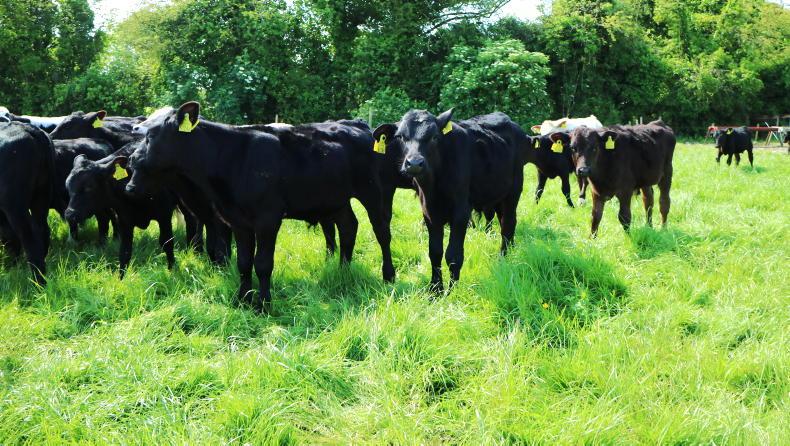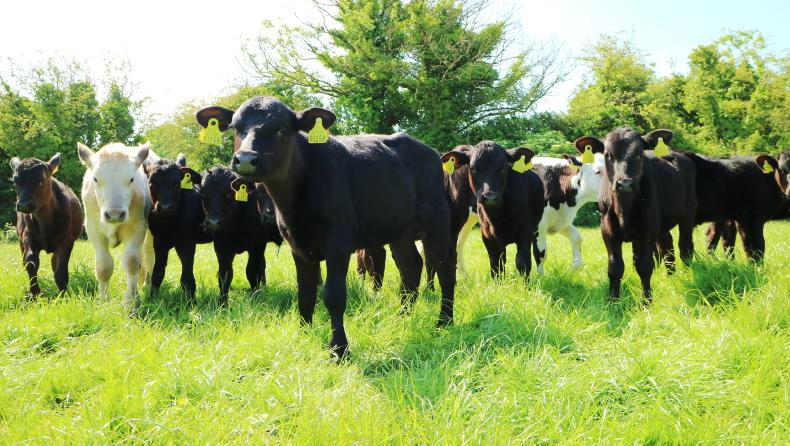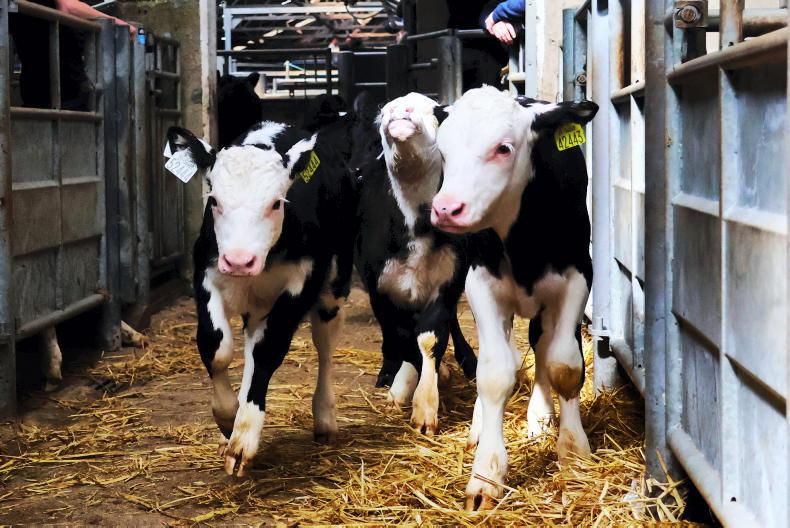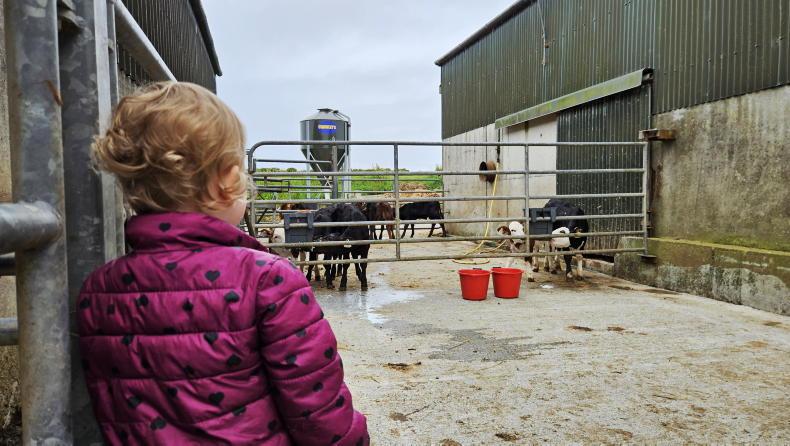Michelle Curley farms alongside her mother Patricia on the outskirts of Prosperous, Co Kildare. The family currently run a herd of just over 40 suckler cows as well as an expanding dairy calf-to-beef enterprise.
Family farm
The Curley farm is very much a family affair, with Michelle’s children Seanpatrick and Charlie both heavily involved with rearing calves in spring and now with the daily routine of feeding meal, moving fences and herding stock to keep on top of any health issues.
This is the Curleys’ first year in the Thrive programme and they started by purchasing nine Angus heifers and nine Angus bulls through the programme.

Michelle Curley farms with her mother in Kildare.
As well as this, Michelle also bought five Hereford calves privately and is artificially rearing two Charolais calves from the suckler herd.
Rearing calves is nothing new to the family, who ran a successful dairy herd until 2004. Michelle is very pleased with how this year’s rearing phase went.
“From the day the calves arrived, they did very well. We kept them in small batches according to size so that everyone got a fair chance.”
Initially, the calves were built up to 2l of milk replacer morning and evening. When calves were over six weeks old, they moved to once-a-day feeding at a rate of 2l/day. This was to encourage greater meal intake and development of the rumen.
They transitioned to once a day feeding by offering lukewarm water as one of the feeds for a couple of days to minimise stress.
“Thankfully, there was almost zero sickness in the calves throughout rearing, which is great as it gives them a really good start. You can see them now at grass really starting to kick on,” Michelle says.
Grazing
The calves are grazing in one batch at the moment and are receiving 1kg of an 18% nut daily. Michelle finds a nut better, as there are no issues with birds eating the meal at grass.

Angus and Hereford calves have been reared this year.
They are getting a fresh break of grass every couple of days with a strip wire being used to allocate grazing.
Where grass goes too strong for the calves, a batch of older cattle can come in and graze it out while the calves move on to more leafy swards.
Suckler switch
The decision to start rearing calves once again is something that was talked about for a few years prior to the family biting the bullet and really going for it this year. The main reason for the change was workload around calving time on the farm.
I think we will keep it at around 40 cows for the next few years
“At the height of the suckler herd, we were calving over 80 cows every year. I do love the suckler herd, but the amount of time we were spending in the sheds around calving time wasn’t sustainable for me with young kids and it’s not fair on Mam at her stage of life to be calving cows,” Michelle explains.
“I think we will keep it at around 40 cows for the next few years, as it is quite manageable. Reducing cow numbers has also allowed us to retain the best breeding cows on the farm. The majority of the cows retained are spring-calving.
“We will see how the dairy-beef enterprise goes over the next couple of years, but so far it really has been enjoyable. I think we will push up calf numbers to around 40 next year.
Our farm is suited to dry summers
“The plan would be to finish as much stock off grass next autumn as possible. In a typical back end, we would manage to keep grazing until late October, so weather depending, we should be able to get them finished without rehousing.
“I think we need to be looking at finishing animals off grass at a younger slaughter age – it plays to the strengths of our ability to grow grass.
“Our farm is suited to dry summers. We are on the edge of the bog here so a spell of weather like we are having just now suits us just fine. Very little of our land would burn up in a dry spell.
“Grass supply on farm is very good at the moment and after-grass is just coming ready for grazing now as well.”
Safety
While rearing calves can also be quite labour-intensive, from a safety point of view, it made more sense with a young family on farm.
It is great that they have an interest and they have each bought their own calves
“The kids are helping with the calves every day. In spring, they were down in the yard to help feed every morning before going to school. It is great that they have an interest and they have each bought their own calves.
“Safety is one thing we are very aware of here. My mother and I are out on the farm at half six every morning to get all the machinery work done before the kids come into the yard. You just can’t be too careful where kids are involved,” Michelle says.
Michelle Curley farms alongside her mother Patricia on the outskirts of Prosperous, Co Kildare. The family currently run a herd of just over 40 suckler cows as well as an expanding dairy calf-to-beef enterprise.
Family farm
The Curley farm is very much a family affair, with Michelle’s children Seanpatrick and Charlie both heavily involved with rearing calves in spring and now with the daily routine of feeding meal, moving fences and herding stock to keep on top of any health issues.
This is the Curleys’ first year in the Thrive programme and they started by purchasing nine Angus heifers and nine Angus bulls through the programme.

Michelle Curley farms with her mother in Kildare.
As well as this, Michelle also bought five Hereford calves privately and is artificially rearing two Charolais calves from the suckler herd.
Rearing calves is nothing new to the family, who ran a successful dairy herd until 2004. Michelle is very pleased with how this year’s rearing phase went.
“From the day the calves arrived, they did very well. We kept them in small batches according to size so that everyone got a fair chance.”
Initially, the calves were built up to 2l of milk replacer morning and evening. When calves were over six weeks old, they moved to once-a-day feeding at a rate of 2l/day. This was to encourage greater meal intake and development of the rumen.
They transitioned to once a day feeding by offering lukewarm water as one of the feeds for a couple of days to minimise stress.
“Thankfully, there was almost zero sickness in the calves throughout rearing, which is great as it gives them a really good start. You can see them now at grass really starting to kick on,” Michelle says.
Grazing
The calves are grazing in one batch at the moment and are receiving 1kg of an 18% nut daily. Michelle finds a nut better, as there are no issues with birds eating the meal at grass.

Angus and Hereford calves have been reared this year.
They are getting a fresh break of grass every couple of days with a strip wire being used to allocate grazing.
Where grass goes too strong for the calves, a batch of older cattle can come in and graze it out while the calves move on to more leafy swards.
Suckler switch
The decision to start rearing calves once again is something that was talked about for a few years prior to the family biting the bullet and really going for it this year. The main reason for the change was workload around calving time on the farm.
I think we will keep it at around 40 cows for the next few years
“At the height of the suckler herd, we were calving over 80 cows every year. I do love the suckler herd, but the amount of time we were spending in the sheds around calving time wasn’t sustainable for me with young kids and it’s not fair on Mam at her stage of life to be calving cows,” Michelle explains.
“I think we will keep it at around 40 cows for the next few years, as it is quite manageable. Reducing cow numbers has also allowed us to retain the best breeding cows on the farm. The majority of the cows retained are spring-calving.
“We will see how the dairy-beef enterprise goes over the next couple of years, but so far it really has been enjoyable. I think we will push up calf numbers to around 40 next year.
Our farm is suited to dry summers
“The plan would be to finish as much stock off grass next autumn as possible. In a typical back end, we would manage to keep grazing until late October, so weather depending, we should be able to get them finished without rehousing.
“I think we need to be looking at finishing animals off grass at a younger slaughter age – it plays to the strengths of our ability to grow grass.
“Our farm is suited to dry summers. We are on the edge of the bog here so a spell of weather like we are having just now suits us just fine. Very little of our land would burn up in a dry spell.
“Grass supply on farm is very good at the moment and after-grass is just coming ready for grazing now as well.”
Safety
While rearing calves can also be quite labour-intensive, from a safety point of view, it made more sense with a young family on farm.
It is great that they have an interest and they have each bought their own calves
“The kids are helping with the calves every day. In spring, they were down in the yard to help feed every morning before going to school. It is great that they have an interest and they have each bought their own calves.
“Safety is one thing we are very aware of here. My mother and I are out on the farm at half six every morning to get all the machinery work done before the kids come into the yard. You just can’t be too careful where kids are involved,” Michelle says.











SHARING OPTIONS